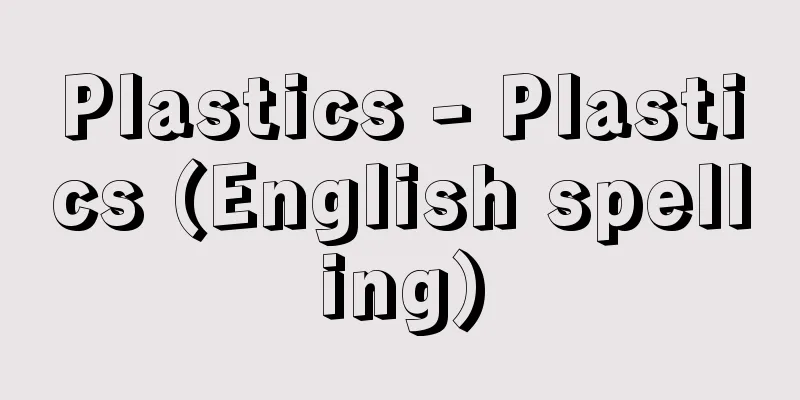Plastics - Plastics (English spelling)

|
Plastic is a general term for natural and synthetic resins, organic polymeric substances that exhibit viscous fluidity when heated and can be molded into a specific shape, but generally speaking, plastic refers to synthetic resins and their molded products. Synthetic fibers and synthetic rubber, both of which are synthetic polymeric substances, can be distinguished by their physical properties, and plastics are somewhere in between. Films, paints, and adhesives are also considered plastics due to the way they are used. Plastic means something that is made of plastic, and comes from the Greek word plastos (to be formed). [Hiroshi Kakiuchi] historyAlthough it is not a synthetic polymeric substance, celluloid, which is made by plasticizing nitrocellulose with camphor, is the forerunner of plastics. Celluloid was invented in 1868 by the American Hyatt brothers. Japan also began producing celluloid in 1905 (Meiji 38), using camphor from Taiwan as a plasticizer, and at one time was the world's largest producer of celluloid, but because it is highly flammable, production volumes have declined. Plastics as synthetic polymers began in 1907 when the American Baekeland applied for a patent for the invention of a molding method for phenolic resin (known as Bakelite). Then, thermosetting resins such as urea resin were invented in 1921 and melamine resin in 1939. Industrial production of unsaturated polyester resin, epoxy resin, etc. followed, mainly after World War II. As for the other type of thermoplastic resin, acrylic resin was produced in 1927, followed by polyvinyl chloride and polystyrene, and then industrial production of high-pressure polyethylene. In the 1950s, the Ziegler-Natta catalyst was invented, and industrial production of low-pressure polyethylene and stereoregular polypropylene began. Currently, polyvinyl chloride, polystyrene, polypropylene, and polyethylene are called the four major plastics, and account for more than 60% of the world's production. From the latter half of the 1930s, polyamide (nylon) and fluororesin were also produced, each with its own unique properties, and were used primarily for military purposes at the time. After World War II, polycarbonate and polyacetal resins were developed. These are stronger than ordinary plastics, have excellent heat resistance and durability, and have been used in place of metal materials as machine components. These in particular are sometimes called engineering plastics. As mentioned earlier, synthetic fibers and rubber have slightly different properties from plastics and each has its own characteristics, so composite technology that combines them to significantly improve impact resistance, rigidity, and temperature resistance has expanded the uses of plastics as materials. They are used in synthetic wood made from ABS resin and fiber-reinforced plastics (FRP). Examples include the hulls of small boats, golf club shafts, rackets, fishing rods, and some aircraft equipment. This composite technology is developing further, and they are now used as components of various electronic devices. Polyurethane and polystyrene foams are also used for various purposes. Plastics made great strides using crude oil as a raw material in the dozen or so years leading up to 1970, when the price of a barrel was $1.28. Plastics are generally easy to mold and can be produced in large quantities, and the molded products are light, non-corrosive, water-resistant, and electrically insulating, and can also be colored. Compared to metals, the disadvantages of plastics are generally poor heat resistance and a low elastic modulus, and one way to improve these is to create composites. Japan's plastic production volume exceeded 100,000 tons in 1955 and has increased rapidly since then, reaching 5 million tons in 1970 and 7 million tons in 1981, but growth has slowed since then, standing at 14.6 million tons in 1999. In terms of value, it accounts for approximately 25% of Japan's chemical industry production. [Hiroshi Kakiuchi] ClassificationPlastics are classified into thermoplastic resins and thermosetting resins depending on the molecular structure of the polymer compounds that compose them. [Hiroshi Kakiuchi] Thermoplastic resinThermoplastics are also called thermoplastics, and are a collection of polymers with a linear structure. When they are heated, the thermal motion of the molecules becomes active and the entanglements of the molecules are loosened. The solid polymer softens and becomes a viscous liquid. If the heat is continued, each molecule of the polymer should break apart and vaporize, but because of the high molecular weight, a considerable high temperature is required for vaporization. If the polymer is heated more strongly, the polymer, which is made of carbon and hydrogen, will decompose thermally, so the best it can be done is to heat it to a viscous liquid. The principle of molding linear polymers is to heat them just before thermal decomposition occurs, press them into a mold in the liquid state, and then cool and mold them. The name thermoplastic polymer was born from the fact that they are polymers that can be heated to soften and become plastic, which means that they can be molded. When a suitable solvent is added to a linear polymer, the entangled polymer molecules loosen, and the solvent molecules coordinate around the polymer, and it becomes dissolved in the solvent. The type of solvent that coordinates well depends on the properties of the polymer molecule and the solvent. Such thermoplastic linear polymers include such as polyvinyl chloride, polystyrene, and polyethylene. Ordinary polystyrene, polymethyl methacrylate, polycarbonate, etc. are non-crystalline and are also called amorphous polymers. Polyvinyl chloride contains fine crystalline parts, but overall it exhibits properties similar to amorphous polymers. Amorphous polymers exhibit a brittle and hard glass state at low temperatures and soft rubber-like properties at high temperatures, so the temperature at which they are used in practice is important. Unlike low-molecular-weight substances, crystalline polymers are polymeric substances that only partially crystallize, and because they have amorphous regions, their properties change significantly near the glass transition temperature, but are not very sensitive otherwise. When crystallizing by cooling from a molten state and molding, the crystals grow from the crystal nuclei that initially precipitated and fold radially to form spherulites. If large spherulites are present, the material becomes opaque to the wavelengths of natural light. This is why polyethylene bottles are opaque. The size of the spherulites affects various physical properties, so it is important to skillfully adjust the cooling speed during molding. When a crystalline polymer is stretched and highly oriented, bundle-like microcrystals are formed, and when this is heat-treated to promote crystallization, it becomes a polymer with high strength and good heat resistance. It is used in synthetic fibers and oriented films. The degree of crystallinity of a polymer can be easily determined using X-rays. [Hiroshi Kakiuchi] Thermosetting ResinsIt is a polymeric substance also known as a thermosetting plastic, and the bonds of the monomers that make it up form a three-dimensional network structure, so it is also called a three-dimensional polymer or cross-linked polymer. Once it has a three-dimensional structure, it no longer becomes liquid even when heated. This is because the molecules are bridged together by strong bonds, and if it is heated even more strongly, the polymer will thermally decompose. Of course, it does not dissolve in any solvent, but it will swell in some solvents. Thermosetting resins are molded by placing small molecular weight monomers or prepolymers that have become somewhat polymeric but still have a linear structure and can melt when heated into a mold, and then causing a chemical reaction inside the heated mold to complete the cross-linking process and form an insoluble, infusible three-dimensional mesh structure. Thermosetting resins are made from materials with polyfunctional structural units that have three or more reactive functional groups as starting materials, and the properties of the cured product are governed by the crosslinking density; the higher the density, the harder and more heat-resistant it is, but the more brittle it becomes. In general, they are mixed with a large amount of fillers or reinforcing agents to improve mechanical strength, heat resistance, electrical properties, etc., and are used to make molded products that are easier to work with, or to impregnate paper, woven fabric, or glass mats with low-viscosity monomers or prepolymers, which are then pressed and heated to make laminates. They are also used in large quantities in paints and adhesives, taking advantage of their low viscosity and easy solubility when applied, and to create three-dimensional structures when completed. As molding and crosslinking occur simultaneously or successively when heated, molding methods different from those used for thermoplastic materials are often used. [Hiroshi Kakiuchi] General manufacturing methodPlastics are now produced in such large quantities because the raw material for them was replaced by petroleum, which was cheap at the time. In the 1950s, the manufacturing process for the core organic chemicals that are the raw materials for coal-based plastics began to rely on petrochemicals, which are made from petroleum, and by 1975, 95% of chemical products were made from petroleum or natural gas. Of the raw materials sent from refineries for chemical use, naphtha (crude gasoline) is the most important, and it is cracked to obtain olefins (alkenes) such as ethylene, propylene, butene (butylene), and butadiene, and aromatic hydrocarbons such as benzene, toluene, and xylene. Heavy diesel oil and refinery gas, which have much higher boiling points than naphtha, are next, and natural gas is also used. These synthetic gases (hydrogen and carbon monoxide) are the raw materials for ammonia, methanol (methyl alcohol), and formalin. The raw materials obtained by naphtha cracking are combined to produce monomers for plastic raw materials. The most important in organic synthesis chemistry are ethylene and benzene. [Hiroshi Kakiuchi] MoldingOne of the characteristics of plastics is that they are easy to mold, which allows them to be mass-produced at low cost. Plastics can be molded in the following forms: (1) liquid (monomer, solution, prepolymer, etc.); (2) powder, flakes, pellet chips, etc.; (3) emulsion (emulsion, latex, etc.); and (4) paste. Liquid plastics are poured into a mold and polymerization is completed. They can also be impregnated into cloth or paper, dried, and molded under pressure and heat. Powdered plastics are often used in the form of pellets. Pellets are made by mixing plastic with colorants and fillers, molding them into a long, thin rod shape, and then cutting them into short pieces. They are cylindrical or rectangular with a diameter or side of 2 to 3 millimeters. There are molding methods suitable for each of the emulsions and paste resins. Molding processes can be further broadly divided into pre-treatment of materials, primary molding, and secondary molding. Pre-treatment includes mixing polymers with additives, kneading, drying, and crushing, while primary molding refers to molding methods and is the mainstream of molding, and secondary molding is post-processing of the primary molded product to increase its added value, such as bonding, printing, painting, and metallizing (surface treatment including plating). [Hiroshi Kakiuchi] Structure and propertiesFor the general characteristics of polymeric substances, please refer to the section on "polymeric compounds." Here, we will describe the relationship between the structure and properties of plastics. [Hiroshi Kakiuchi] Molecular weight and molecular weight distributionThe molecules of synthesized plastics are not made up of a single molecular weight component, but are a mixture of homologs with different molecular weights. This is because the synthesis method of polymers follows statistical rules, and the molecular weight is the average molecular weight. The average means that there is a distribution of molecular weights of various sizes. The wider the polydispersity, the more non-crystalline and flexible the properties are. shows the correlation between molecular weight and crystallinity, as well as the physical properties, using polyethylene as an example. Plastics with a certain degree of crystallinity and a large molecular weight are strong, but beyond that point they become difficult to mold and are not suitable for practical use. In the case of thermosetting resins, the molecular weight cannot be measured because they do not become a plastic solution after curing. Here, the crosslink density of the three-dimensional structure is related to the physical properties. [Hiroshi Kakiuchi] Chemical structure, conformation and crystallinityIt is basically possible to discuss the relationship between the chemical structure and properties of plastics, but in practice this is difficult because various additives are used in actual products. Heat resistance, oil resistance, water resistance, abrasion resistance, and electrical properties can decrease or increase depending on the types of atomic groups that make up the plastic. The effects of the types of atomic groups on the properties of plastics are extremely diverse. Along with chemical structure, the three-dimensional structure and crystallinity of the molecular chains that make up the plastic are also important factors. Crystallization is related to the temperature characteristics of the mechanical properties of plastics. shows the relationship between crystallinity, G', which corresponds to the elastic modulus of amorphous polymers, and the measurement temperature. When the glass transition temperature Tg is exceeded, the elastic modulus of amorphous polymers drops by three to four orders of magnitude, changing from a glassy state to a rubbery state, while crystalline polymers maintain a relatively high elastic modulus. Tan δ in is called the dielectric loss. When a plastic sample is placed in an electric field, the permanent dipoles (electron bias) present in the plastic molecules are oriented in a certain direction in the electric field. At this time, the delay in orientation when the voltage of the electric field is changed becomes heat and causes a loss of power. The temperature at which this loss appears varies depending on the type of motion of the chemical bonds in the plastic. shows the type of motion, the temperature at which it appears, and the magnitude of tan δ at that time. Polymer crystals are formed by regularly arranging parts of long molecular chains in a fixed shape, and only polyethylene produced by the low-pressure method has a planar zigzag shape in which the main chain bonds are in a trans configuration and extend in one direction. Other materials with similar crystal shapes include nylon and polyethylene terephthalate (Tetoron). When vinyl monomer CH2 =CHR is polymerized, it becomes a polymer with head and tail bonded. The carbon-carbon bond of this polymer has an angle of 109.28 degrees, so it is arranged as shown in The substituent R can have three different spatial arrangements as shown in the figure. Imagine a human walking on this carbon-carbon bond. In (a), the walking human always finds the substituent R at the top, in (b), the human finds R alternately at the top and bottom, and in (c), the ratio of R found at the top and bottom is completely irregular, but overall it is half and half. A polymer with the configuration (a) is called an isotactic polymer, (b) is called a syndiotactic polymer, and (c) is called an atactic polymer. The regular arrangement of (a) and (b) is called stereoregularity, and it is because of this that the polymer has polymer crystallinity. Atactic polymers without regularity are difficult to crystallize. Polyvinyl alcohol is an exception, as it crystallizes even in the atactic state. Special catalysts and polymerization conditions are required to create stereoregularity, and under normal conditions an atactic polymer is formed. Thermosetting resins have an irregular molecular structure, and the thermal motion of the molecular chains is restricted by crosslinks and branches, and they do not crystallize. In this case, the factors that govern the mechanical strength and glass transition temperature are the crosslink density. [Hiroshi Kakiuchi] Mechanical propertiesWhen using polymeric substances, including plastics, as materials, it is necessary to evaluate their mechanical properties. Tensile tests were conducted on three types of polymeric substances, such as polystyrene, polyethylene, and natural rubber, and the relationship between the tensile force (stress) and the resulting deformation was as shown in When a force was applied to a sample rod (cross-sectional area of 1 square centimeter) and it was pulled, a curve like the one in the figure was obtained. Polystyrene is crystalline and rigid, and breaks before it stretches much. Polyethylene initially deforms in proportion to the stress, but after the yield point, a slight change in external force causes a large amount of deformation, meaning that the polyethylene molecules flow inside the rod in the direction of the pull, and the molecules rearrange. Natural rubber stretches drastically with a slight change in external force. It has so-called rubber elasticity, and returns to its original length when the force is removed. If it is pulled further, the molecules rearrange and crystallize, and it finally breaks. The mechanical properties of thermosetting resins are similar to those of polystyrene, but their breaking strength is greater. This is because they have a cross-linked structure within their molecules. A convenient method for evaluating their mechanical properties is to make a test piece, perform a tensile test, and obtain a stress-strain curve like (1). The shape of the curve and the size of the shaded area allow the properties to be evaluated like (2). Recently, a new evaluation method has been developed in which a test piece with a notch is made, the hole is widened to the left and right, and the energy G1 that breaks the piece from the notch is measured. Plastics are softer than metals and are more susceptible to scratches on the surface. However, because their surfaces are soft and elastic, they can be easily deformed and return to their original shape when the load is removed, making them useful in a variety of applications. Compared to metals, plastics have the advantages of not rusting and being lightweight, but they have disadvantages in that they have a low elastic modulus (the value obtained by dividing the force applied to plastic by the amount of deformation; there are various elastic moduli depending on the type of stress, and this is a typical physical property of plastics) and are poor in heat resistance and flame retardancy. [Hiroshi Kakiuchi] Thermal propertiesThe softening point and thermal decomposition temperature of plastics are important information for molding. When using plastic products in practice, it is necessary to know data such as the heat resistance temperature during long-term continuous use, repeated heat resistance temperature, and the temperature at which it deforms due to heat (thermal deformation temperature). The usable temperatures for general plastics are phenolic resin (unfilled) = 120-130°C, phenolic resin (asbestos-filled) = 160°C, unsaturated polyester resin (cast) = 95-100°C, and molded polyurethane = 110°C (all long-term heat resistance temperatures of 90 days or more). Heat resistance differs depending on the structure; in thermoplastic resins, it is related to the types of atoms that make up the plastic, the strength of their bonds, and the molecular weight, while in thermosetting resins, it is related to the crosslink density, etc. The linear expansion coefficient of thermoplastic resins is about 10 times that of metals, at about 1 x 10 -4 /K. This large value is often a drawback in engineering applications, but by combining them, it can be improved to a value comparable to that of metals. Plastics generally do not conduct heat well. Their thermal conductivity is about 1/100 of that of metal materials. Foam plastics are used as insulation materials, and their thermal conductivity is even lower. [Hiroshi Kakiuchi] Electrical propertiesPlastics are used as insulators. Films of plastics are fused by high-frequency dielectric heating, and values such as volume resistivity, insulating strength, and dielectric constant, which are related to contamination caused by static electricity on the surface, are measured. [Hiroshi Kakiuchi] Weather and light resistanceThe amount of plastics used outdoors, which are lightweight and rust-resistant, is increasing. The outdoor lifespan is mainly determined by photodegradation caused by ultraviolet rays, and various other external factors are also involved. Methods such as adding stabilizers and mixing inorganic fillers are being used. Estimates of the outdoor lifespan of commercially available thermoplastic resins are as follows (from Kodachi Kosei's "Plastic Materials"). Medium-impact polystyrene = 2-3 years, AS resin = 4-5 years, high-rigidity ABS resin = 2.5-3.5 years, medium-impact resin = 2-3 years, high-impact ABS resin = 1.5-2 years, glass fiber reinforced ABS resin = 1-3 years, AAS resin = 4-5 years (6-7 years), ACS resin = 4-5 years (6-7 years), polycarbonate = 7-8 years, polypropylene (general grade) = 1 year, inorganic reinforced polypropylene = 1 year, polyethylene = 1 year, polyvinyl chloride = 3-4 years. *The numbers in parentheses are when a small amount of stabilizer is added. When plastics are exposed to light, especially short-wavelength ultraviolet light, the energy is absorbed and photodecomposition can begin. In many cases, light stabilizers are added before molding. [Hiroshi Kakiuchi] Flame retardantPlastics, which are mainly made of carbon, are combustible. Flame retardant measures involve the introduction of flame retardants or elements into the molecular structure that release inert gases during combustion to block air and suppress rapid combustion. The minimum amount of oxygen required to burn a material is called the oxygen index, and is expressed as (100 x oxygen) / (oxygen + nitrogen). Materials with smaller numbers are more flammable. Incidentally, the oxygen indexes of major plastics are: polyethylene oxide = 15.0, polymethylmethacrylate = 17.3, polystyrene = 18.2, polyethylene = 19.0, polypropylene (FR) = 29.2, polyester = 41.5, epoxy resin = 47.6, polytetrafluoroethylene = 95.0 (from Issaacs, Mod.Plast ). [Hiroshi Kakiuchi] Plastic waste processing As the amount of plastic produced increases, disposal of plastic after use has become a problem. Up until now, more than 70% of waste in Japan has been incinerated as garbage, and much of the plastic waste has also been incinerated. However, it is well known that when chlorine-containing plastic waste such as polyvinyl chloride and polyvinylidene chloride is incinerated, dioxins, which are considered to be endocrine disrupting substances (environmental hormones), are generated as pyrolysis products at temperatures below 800°C. Dioxins are highly bioaccumulative and difficult to biodegrade chemicals. It has been discovered that dioxins are re-decomposed and disappear when the temperature of the incinerator is kept at a high temperature of 1000°C or higher, so large furnaces that can continuously incinerate at high temperatures have been developed. At present, plastic waste from households is visually separated from polyvinyl chloride, then cut into small pieces, and then thermally decomposed to recover heavy hydrocarbon oil. Industrial waste is disposed of in specialized incinerators, but a method that is attracting attention is to use the polyvinyl chloride as thermal energy by preheating it to release hydrochloric acid, and then crushing the plastic waste and feeding it into a steelworks blast furnace or a cement manufacturing kiln. The amount of plastic waste generated, including disposable containers and PET bottles, which are convenient for use and consumption, has increased significantly. The Recycling Law was enacted in 1991 with the aim of making effective use of resources, reducing waste generation, and preserving the environment, and the Container and Packaging Recycling Law was enacted in 1995 with the aim of promoting the recycling of containers and packaging that can be used as recyclable resources. The latter law aims to build a social system in which consumers, municipalities, and businesses share responsibility for container and packaging, and each party actively works to reduce waste generation and promote recycling. Consumers are required to cooperate with municipalities in sorting and collection, and businesses that manufacture or use specified containers are obligated to recycle the container and packaging waste that has been sorted and collected by municipalities according to the amount of use and production. As a result, for example, PET bottles that have been sorted and collected are washed, foreign matter removed, and crushed, and then recycled into flake-shaped PET resin, which is used for pillows, ski wear stuffing, carpet lining, etc. [Hiroshi Kakiuchi] Development of new technologies and applicationsOf the three major materials, metals, ceramics and polymeric materials, plastics have various characteristics and are produced in large quantities at low cost because they are made from petroleum. However, the growth rate of the production of plastics as a material has been declining significantly in developed countries such as Japan. This is because production has increased in crude oil producing countries and developing countries. [Hiroshi Kakiuchi] Functional plastics and compositesFunctional plastics, which are plastics that have been endowed with various functions such as electrical conductivity, photosensitivity, separability, energy conversion, and biocompatibility through chemical reactions, are beginning to demonstrate their value as special materials in practical applications. Since the 1980s, applications have expanded particularly to electronics, optoelectronics, bicycles and aircraft, and packaging, and in manufacturing and processing technologies, there have been developments in adhesion and separation technologies. Another development is composites. In other words, by combining two or more different materials with different properties in various ways, they are able to exhibit excellent properties that the materials alone do not have, improving heat resistance, impact resistance, dimensional stability, and moisture resistance, and they are now used as a substitute for metals, including in terms of cost. These include super engineering plastics, thermoplastic elastomers, plastic alloys, and interpenetrating polymer networks (IPNs). In particular, the use of fiber-reinforced plastics (FRPs) made from prepregs made by impregnating glass or carbon fibers with thermosetting resins is remarkable. In addition, plastics have the characteristic of being much more compatible with the human body than metals or ceramics, which is why they are used in many medical devices. [Hiroshi Kakiuchi] "Murahashi Shunsuke, Oda Ryohei, and Imoto Minoru, Revised New Edition Plastic Handbook" (1976, Asakura Shoten)" ▽ "Fujii Mitsuo and Kakiuchi Hiroshi, Practical Knowledge of Plastics" (1974, Toyo Keizai Shinposha)" ▽ "Furukawa Junji, New Polymer Materials (1987, Chemical Doujin)" ▽ "Kurata Masaya, Plastic Materials Technology Reader" (1988, Nikkan Kogyo Shimbun)" ▽ "Takeuchi Shigeya and Kitano Hiroki, "The World of Polymers" (2000, Shokabo)" [Reference Items] | | | | | | | | | | | | | Compound | | | Plastic | | | | | | | | | | | | | | | | | | Fluorine | | | | | | | | | | | |©Shogakukan "> Relationship between the crystallinity, molecular weight and properties of polymers (... ©Shogakukan "> G'-T curves of crystalline polymers and amorphous polymers... ©Shogakukan "> Conceptual diagram of stereoregular polymers [Figure C] ©Shogakukan "> Stress-deformation curve of polymeric materials [Figure D] Source: Shogakukan Encyclopedia Nipponica About Encyclopedia Nipponica Information | Legend |
|
プラスチックとは、加温した状態で粘い流動性を示し、所定の形に成形できる有機高分子物質のなかの天然樹脂、合成樹脂の総称であるが、普通、プラスチックといえば合成樹脂およびそれらの成形物をさす。同じ合成高分子物質である合成繊維と合成ゴムとは、その物性で区別することができ、それらの中間に位置するものである。フィルム、塗料と接着剤もその使用形態上からプラスチックとみなされている。プラスチックとは可塑物という意味で、ギリシア語のplastos(形成される)に由来する。 [垣内 弘] 歴史合成の高分子物質ではないが、ニトロセルロースを樟脳(しょうのう)で可塑化したセルロイドがプラスチックの先駆けである。セルロイドは1868年にアメリカのハイアット兄弟によって発明された。日本でも1905年(明治38)から生産され、台湾産の樟脳を可塑剤として利用し、世界一の生産をあげた時期もあったが、非常に燃えやすいのでその生産量が減少していった。 合成高分子としてのプラスチックは、1907年にアメリカのベークランドによるフェノール樹脂(いわゆるベークライト)の成形法発明の特許申請に始まる。ついで1921年にユリア樹脂(尿素樹脂)、1939年にメラミン樹脂などの熱硬化性樹脂が発明されていった。さらに主として第二次世界大戦後に不飽和ポリエステル樹脂、エポキシ樹脂などの工業的生産が続いていった。もう一方の熱可塑性樹脂は、アクリル樹脂が1927年に、さらにポリ塩化ビニル、ポリスチレンが生産され、高圧法のポリエチレンなどの工業的生産がそれに続いた。1950年代にツィーグラー‐ナッタ触媒が発明され、低圧法ポリエチレン、立体規則性ポリプロピレンの工業的生産が始まった。現在、ポリ塩化ビニル、ポリスチレン、ポリプロピレン、ポリエチレンが四大プラスチックとよばれ、世界の生産量の60%以上を占めている。 1930年代の後半からポリアミド(ナイロン)やフッ素樹脂もつくられ、それぞれ特異な性質で、当時は主として軍需用として使用された。第二次世界大戦後はポリカーボネートやポリアセタール樹脂が開発された。これらは一般のプラスチックに比べてじょうぶで、耐熱性や耐久性に優れ、金属材料にかわって機械構成要素として用いられてきた。とくにこれらはエンジニアリング・プラスチックといわれることもある。 先に述べたように合成繊維やゴムはプラスチックとやや性質を異にし、それぞれの特徴をもっているので、複合化して、耐衝撃性、剛直性、耐用温度を著しく改善する複合化技術がプラスチックの材料としての用途を拡大した。ABS樹脂による合成木材や、繊維強化プラスチック(FRP)として利用されている。小型船舶船体やゴルフクラブのシャフト、ラケット、釣り竿(ざお)、航空機機材の一部などがその一例である。この複合化はますます発展し、各種電子機器の構成材料になっている。また発泡体としてポリウレタンやポリスチレンも各種用途に応用されている。 プラスチックは原油が1バレル1ドル28セントという1970年ころまでの十数年間に、これを原料として大きく発展してきた。プラスチックは一般に成形が容易で、多量に生産され、その成形品は軽く、腐食もせず耐水性や電気絶縁性にも優れ、着色も可能である。金属に比べての欠点は一般に耐熱性に乏しいことと、弾性率の小さいことであり、これらを改良していく一つの方法が複合化である。 日本のプラスチックの生産量は1955年(昭和30)に10万トンを超え、それ以降急激に増加し、1970年に500万トン、1981年には700万トンに達したが、それ以降の伸びは鈍化し、1999年は1460万トンであった。金額では日本の化学工業生産の約25%を占める。 [垣内 弘] 分類プラスチックは、それを構成している高分子化合物の分子構造によって、熱可塑性樹脂と熱硬化性樹脂とに分類される。 [垣内 弘] 熱可塑性樹脂熱可塑性プラスチックともよばれ、線状構造の高分子の集合であり、これを加熱していくと分子の熱運動が盛んになり、分子の絡み合いがほどけてくる。固体の重合体(ポリマー)が柔らかくなり、粘い液体となる。さらに加熱を続けると、本来ならばポリマーの各分子がばらばらになって気化するはずであるが、高分子量であるために気化には相当の高温を必要とする。さらに強く加熱すると、炭素や水素からできているポリマーの熱分解がおこるので、粘い液体程度まで加熱させるのが精いっぱいである。熱分解がおこる直前まで加熱して、液体の状態で型の中に押し込み、冷却して成形するのが線状ポリマーの成形法の原理である。加熱して柔らかくなり、可塑性という成形可能な状態にもってくることができるポリマーという意味で熱可塑性ポリマーという名称が生まれてきた。また、線状のポリマーはそれを溶解するような適当な溶媒を加えると、絡み合ったポリマー分子がほぐれ、その高分子の周りに溶媒分子が配位して、その溶媒に溶けた状態になる。どのような溶媒がよく配位するかは、ポリマー分子と溶媒との性質によって決まってくる。 このような熱可塑性の線状ポリマーにはポリ塩化ビニル、ポリスチレン、ポリエチレンのようなものが属している。 通常のポリスチレン、ポリメタクリル酸メチル、ポリカーボネートなどは非結晶性であり、無定形高分子ともよんでいる。ポリ塩化ビニルは細かい結晶部分を含むが、全体としては無定形ポリマーに近い性質を示す。無定形ポリマーはガラス転移温度を境にして、低温側ではもろくて硬いガラス状態を示し、高温側では柔らかいゴム状の性質を示すので、実用面での使用温度が重要になってくる。結晶性ポリマーは、低分子物質と異なり高分子物質のため部分的にしか結晶化せず、無定形領域が存在するために、ガラス転移温度付近での性質の変化は大きいが、それ以外はそれほど敏感ではない。溶融状態から冷却して成形する場合の結晶化では、初めに析出した結晶核から放射状に折り畳んだ結晶として成長して球晶を形成する。大きな球晶が存在すると自然光線の波長に対して不透明となる。ポリエチレンの瓶が不透明となっているのはそのためである。球晶の大きさはいろいろの物性に影響するので、成形時の冷却速度などを上手に調節することが重要である。結晶性ポリマーを引き伸ばして高度に配向させると束(たば)状の微結晶が生成し、これを熱処理して結晶化を進めれば、高強度で耐熱性のよいポリマーになる。合成繊維や延伸フィルムに利用されている。ポリマーの結晶化度はX線によって簡単に求めることができる。 [垣内 弘] 熱硬化性樹脂熱硬化性プラスチックともよばれる高分子物質であるが、それを構成している単量体(モノマー)の結合が三次元の立体的な網目構造をもったもので、三次元ポリマーまたは架橋ポリマーともよんでいる。三次元立体構造にできあがったものは加熱してももはや液体にはならない。互いの分子が固い結合によって橋架け化されているからで、さらに強く加熱するとポリマーの熱分解がおこる。もちろん、どんな溶媒にも溶けないで、ある種の溶媒では膨潤する。 熱硬化性樹脂の成形は、分子量の小さいモノマーや、やや高分子になっているが、まだ線状構造で加熱によって溶融する程度のプレポリマーprepolymerを型の中に入れ、加熱した型の内部で化学反応をさせ、橋架け化を完成させて不溶不融性の三次元網目構造を形成させる。 熱硬化性樹脂は反応しうる官能基を三つ以上もった多官能性構造単位をもった物質を出発物質としていて、硬化物物性を支配するものに橋架け密度(架橋密度)があり、この密度の高いものほど硬くなり、耐熱性も上昇するが、もろくなる。一般に多量の充填(じゅうてん)剤(フィラーfiller)や補強剤を混合して機械的強度、耐熱性、電気特性などを改良して作業性を改良する成形品や、紙や織布あるいはガラスマットなどにモノマーないしプレポリマーの低粘度の形で含浸させ、加圧・加熱によって積層板(ラミネートlaminate)の形にした利用法も広く行われている。塗料、接着剤なども、施工するときは低粘度、易溶性の特長を生かし、完成したときは三次元構造をもたせる用法として多量に使用されている。 成形法も、加熱によって成形と橋架け化が同時にまたは連続しておこるので、熱可塑性のものと異なった成形法が採用される場合が多い。 [垣内 弘] 一般的な製造法プラスチックが現在のように多量に生産されるようになったのは、その原料がその当時安価であった石油に切り替わったためである。1950年代に石炭を基盤とするプラスチックの素材である基幹有機化学品の製造プロセスが、石油を原料とする石油化学に依存し始め、1975年の時点で化学製品の実に95%が石油ないし天然ガスを原料とするようになった。製油所から化学用に送られてくる原料のうちナフサ(粗製ガソリン)がもっとも重要で、これを分解してエチレン、プロピレン、ブテン(ブチレン)、ブタジエンのようなオレフィン(アルケン)と、ベンゼン、トルエン、キシレンなどの芳香族炭化水素が得られる。ナフサより沸点のずっと高い重質軽油と製油所ガスがナフサに続き、さらに天然ガスも利用されている。これらの合成ガス(水素と一酸化炭素)は、アンモニア、メタノール(メチルアルコール)、さらにホルマリンの原料である。ナフサ分解によって得られた素原料を組み合わせてプラスチック原料の単量体を製造していく。有機合成化学上もっとも重要なものはエチレンとベンゼンである。 [垣内 弘] 成形加工プラスチックの特徴の一つは成形加工が容易なことで、そのために多量生産方式で成形品を安価に製造しうる。プラスチックの成形用素材の形態は、(1)液体(モノマー、溶液、プレポリマーなど)、(2)粉末、フレーク、ペレットチップなど、(3)乳濁液(エマルジョン、ラテックスなど)、(4)ペーストなどで、液体のものは型に注いでから重合を完結させるものである。また布や紙などに含浸させ、乾燥して加圧・加熱下に成形する。粉末状のものは多くはペレットpelletの形で利用する。ペレットとは、プラスチックに着色剤、充填材などを混合して細長い棒状に成形したものを短く切断したもので、径または一辺が2~3ミリメートルの円柱または角柱状のものである。乳濁液やペースト樹脂などはまたそれぞれに適した成形加工法がある。 さらに成形加工を大別すると、素材の前処理、一次成形加工と二次成形加工に分けられる。前処理とは、ポリマーと添加剤との混合、混練、乾燥、粉砕などの処理であり、一次成形加工は成形加工法を意味し、成形加工の本流ともいうべきもの、二次成形加工とは、一次でできた成形品を後加工して付加価値を高める加工であり、接着、印刷、塗装、メタライジング(めっきを含む表面加工)などである。 [垣内 弘] 構造と性質高分子物質の一般的特徴は「高分子化合物」の項を参照されたい。ここではプラスチックとしての構造と性質との関連性について記述する。 [垣内 弘] 分子量と分子量分布合成されたプラスチックの分子は単一の分子量成分からは成り立たないで、分子量の異なる同族体の混合物である。ポリマーの合成法が統計的な規則に従うからであり、その分子量は平均分子量である。平均ということはいろいろな大きさの分子量が分布していることを意味する。多分散性が広幅のものほど非結晶性で可撓(かとう)性のある性質を示す。この分子量の大小と結晶化度、ならびにその物性との相関図はポリエチレンを例にとるとのようである。ある程度の結晶性をもち分子量が大きいプラスチックは強靭(きょうじん)であるが、その程度をすぎると成形性が悪くなり実用に適さない。 熱硬化性樹脂では、硬化したあとはプラスチックの溶液とならないので分子量を測定できない。ここでは三次元構造の架橋密度が物性と関係してくる。 [垣内 弘] 化学構造および立体構造と結晶性プラスチックの化学構造と性質の関係を議論することは基本的には可能であるが、実際の製品にはいろいろな添加剤が使用されているので実用的には困難である。構成している原子団の種類によって耐熱性、耐油性、耐水性、耐摩耗性、電気的性質が低下もすれば増加もする。原子団の種類がプラスチックの性質に及ぼす効果は実に多様なものとなっている。 化学構造と並んで重要な要因は、プラスチック構成分子鎖の立体構造と結晶性である。結晶化はプラスチックの力学的性質の温度特性などに関係している。は、結晶性と無定形高分子の弾性率に相当するG′と測定温度との関係図である。無定形のものはガラス転移温度Tgを超えると弾性率は3~4桁(けた)も低下して、ガラス状態からゴム状態に変わるのに対して、結晶性のものは比較的高い弾性率を保持している。のtanδは誘電体損失とよんでいるもので、プラスチック試料を電場内に置くと、プラスチックの分子内に存在する永久双極子(電子の偏り)が電場内で、ある方向に配向する。このとき電場の電圧を変化させたときの配向の遅れが発熱となり電力を損失する。この損失の現れる温度は、プラスチック内での化学結合のいろいろな運動の種類によって異なる。はその運動の種類とそれが出現する温度、そのときのtanδの大きさを示している。ポリマーの結晶は、長い分子鎖の一部分が定まった形態をとって規則正しく配列したものであり、ポリエチレンでは低圧法でつくられたもののみが、主鎖結合がトランス型配置で一方向に伸びた平面ジグザグ形態をとっている。これに似た結晶形はナイロンやポリエチレンテレフタレート(テトロン)などがある。 CH2=CHRというビニルモノマーを重合させると頭と尾が結合したポリマーになる。このポリマーの炭素‐炭素結合は109.28度の角度をもっているから、のような配置になる。置換基Rが図のような3種類の異なった空間配置をとりうる可能性をもっている。この炭素‐炭素結合の上を人間が歩くとしよう。の(a)では歩く人間はつねに上のほうに置換基Rをみいだし、の(b)では上下かわるがわるにRをみいだし、の(c)では上と下にみいだす割合はまったく不規則だが全体として半分ずつという場合である。(a)の立体配置をもったポリマーをアイソタクチックポリマーisotactic polymer、(b)をシンジオタクチックポリマーsyndiotactic polymer、(c)をアタクチックポリマーatactic polymerと名づけている。(a)と(b)の規則正しい配列、それを立体規則性とよぶが、そのために高分子結晶性をもっている。規則性のないアタクチックポリマーは結晶化しにくい。ポリビニルアルコールは例外で、アタクチックでも結晶化している。立体規則性をつくるための条件は特殊な触媒や重合条件を必要とし、普通の条件ではアタクチックポリマーが生成している。 熱硬化性樹脂では分子構造が不規則であり、架橋や枝分れのために分子鎖の熱運動が束縛されているし、結晶化もしない。この場合の機械的な強度を支配する因子やガラス転移温度などを支配する因子は架橋密度である。 [垣内 弘] 機械的性質プラスチックを含めて高分子物質を材料として利用するときは、その機械的性質の評価が必要となる。いろいろな高分子物質、たとえばポリスチレン、ポリエチレンと天然ゴムの3種類の引張り試験を行い、引っ張る力(応力)とそれによって生じる変形との関係はのようである。試料の棒(断面積1平方センチメートル)に力を加えて引っ張っていくと、図のような曲線が得られる。ポリスチレンは結晶性で剛直であり、あまり伸びないうちに切断する。ポリエチレンは初めは応力に比例して変形するが、降伏点を過ぎるとわずかの外力の変化で変形量の大きな状態、すなわちポリエチレン分子がその棒の内部で引っ張る方向に流動し、分子の再配列がおこる。天然ゴムはわずかな外力の変化で激しく伸びる。いわゆるゴム弾性で、力を取り去ると元の長さに戻る。さらに引っ張っていくと分子が再配列して結晶化し最後に切断する。 熱硬化性樹脂の機械的性質はポリスチレンのそれに近い形状を示すが、破壊強度はもっと大きい値を示す。分子内に架橋構造を有しているからである。機械的性質を評価する便宜的な方法は、テストピースをつくり、引張り試験を行い、の(1)のような応力―変形量曲線を得る。その曲線の形や斜線を施した面積の大小での(2)のような性質が評価できる。 最近は切り込みの入ったテストピースをつくり、孔(あな)のあいたところを左右に広げ、切り込みから破壊していくエネルギーG1を測定するのが新しい評価方法となっている。 プラスチック類は金属に比べて柔らかく、表面に傷がつきやすい。しかし、表面が柔らかく弾性をもっているため容易に変形し、荷重を除くと元に戻るので、いろいろな方面に利用できる。 プラスチックの金属に比べての特徴は錆(さ)びないことと軽いことであるが、欠点は弾性率(プラスチックに加えた力を変形量で割った値で、応力の種類によっていろいろな弾性率があり、プラスチックの物性値として代表的なもの)が小さく、また耐熱性や難燃性に乏しいことである。 [垣内 弘] 熱的性質プラスチックの軟化点や熱分解温度は成形加工時の重要な情報である。プラスチック製品の実際使用に際しては、長期の連続使用時の耐熱温度、反覆耐熱温度や、熱によりそれが変形する温度(熱変形温度)などのデータを知る必要がある。一般的なプラスチックの使用可能温度は、フェノール樹脂(無充填)=120~130℃、フェノール樹脂(アスベスト充填)=160℃、不飽和ポリエステル樹脂(キャスト)=95~100℃、成形ポリウレタン110℃である(いずれも90日以上の長期耐熱温度)。 耐熱性はその構造によって異なり、熱可塑性樹脂ではプラスチックを構成している原子の種類とそれらの結合手の強弱、分子量の大小、熱硬化性樹脂では架橋密度などが関係してくる。 熱可塑性樹脂の線膨張係数は、金属の約10倍で1×10-4/Kぐらいである。この大きな値は工学的な利用に際して欠点となることが多いが、複合化することによって金属と同程度の値に改善することができる。 プラスチックは一般に熱を通しにくい。熱伝導率は金属材料の100分の1程度である。断熱材として用いるものは発泡プラスチック(フォームプラスチック)で、熱伝導率はさらに小さくなる。 [垣内 弘] 電気的性質プラスチックは絶縁体として用いられている。また、そのフィルムなどを高周波誘電加熱によって融着し、表面での静電気発生による汚染などと関係する体積固有抵抗、絶縁強さ、誘電率などの値が測定されている。 [垣内 弘] 耐候性と耐光性軽量かつ錆びないという特徴をもったプラスチックの屋外での使用量が増加している。屋外での使用寿命を左右するものは、紫外線による光劣化を主とし、そのほかにいろいろな外的因子が関係してくる。安定剤の添加や無機質充填材の混合などの方法が行われている。市販熱可塑性樹脂の屋外使用寿命の推定値は以下のとおりである(小太刀功成『プラスチックマテリアル』より)。中衝撃性ポリスチレン=2~3年、AS樹脂=4~5年、高剛性ABS樹脂=2.5~3.5年、中衝撃性樹脂=2~3年、高衝撃性ABS樹脂=1.5~2年、ガラス繊維強化ABS樹脂=1~3年、AAS樹脂=4~5年(6~7年)、ACS樹脂=4~5年(6~7年)、ポリカーボネート=7~8年、ポリプロピレン(一般グレード)=1年、無機質強化ポリプロピレン=1年、ポリエチレン=1年、ポリ塩化ビニル=3~4年。*( )内の数字は若干の安定剤を添加した場合。 プラスチックに光とくに短波長の紫外線が照射されると、そのエネルギーが吸収されて光分解が始まることがある。光安定剤を加えて成形する例が多い。 [垣内 弘] 難燃性主として炭素からできているプラスチックは燃焼する。難燃剤や、分子構造中に燃焼時に不活性ガスを放出して空気を遮断するような元素を導入して、急激な燃焼を抑制することが難燃化対策である。材料を燃焼させるために最低必要な酸素量を酸素指数といい、(100×酸素)/(酸素+窒素)で表す。数字の小さいものが燃えやすい。ちなみにおもなプラスチックの酸素指数は、ポリエチレンオキシド=15.0、ポリメタクリル酸メチル=17.3、ポリスチレン=18.2、ポリエチレン=19.0、ポリプロピレン(FR)=29.2、ポリエステル=41.5、エポキシ樹脂=47.6、ポリテトラフルオロエチレン=95.0となっている(Issaacs,Mod.Plastより)。 [垣内 弘] プラスチック廃棄物の処理プラスチックの生産量の増大とともに、使用されたあとの廃棄が問題となってきた。もともとプラスチックは、 いままで日本では廃棄物の約70%以上がごみとして焼却され、プラスチック廃棄物もその多くは焼却されてきた。しかしポリ塩化ビニルやポリ塩化ビニリデンなど塩素含有プラスチック廃棄物を焼却したとき、800℃以下の温度では熱分解生成物として内分泌攪乱(かくらん)物質(環境ホルモン)とみなされているダイオキシンが発生することはよく知られている。ダイオキシンは生物蓄積性がきわめて高く、かつ難生解性の化学物質である。焼却炉の温度を1000℃以上の高温に保つとダイオキシンが再分解して消失することがわかってきたので、高温で連続的に焼却する大型炉が開発されている。現時点では家庭からのプラスチック廃棄物はポリ塩化ビニルを目視などで分別し、のちに小さく切断してから、加熱分解して炭化水素系の重質油を回収する。産業廃棄物は専門の焼却炉で処理されるが、ポリ塩化ビニルを予備過熱して塩酸として脱離したあと、各プラスチック廃棄物を粉砕して製鉄所の高炉に投入したり、またはセメント製造用のキルン(焼成炉)に投入したりして、熱エネルギーとして活用する方法が注目されている。 使用、消費に便利な使い捨て容器やペットボトルなどプラスチック類のごみの発生量は著しく増大した。資源の有効利用、廃棄物の発生抑制および環境の保全を目的として、1991年にリサイクル法が、また再生資源としての利用が可能な容器包装についてリサイクルを促進することを目的として、1995年に容器包装リサイクル法が制定された。後者は、容器包装について、消費者、市町村、事業者のそれぞれが責任を分担することにより、それぞれがごみの排出抑制、リサイクルの促進に積極的に取り組む社会システムの構築を目ざすものである。消費者は、市町村が行う分別収集に協力し、また特定容器を製造したり利用したりする事業者は、市町村が分別収集した容器包装廃棄物を、その使用量や製造量に応じて、再商品化を行う義務を負うことになった。これにより、たとえば分別回収されたペットボトルは、洗浄、異物除去、粉砕したのち、フレーク状のペット樹脂に再生され、枕やスキーウェアのつめ綿、カーペットの裏地などに利用されている。 [垣内 弘] 新技術・用途の開発三大素材といわれる金属、セラミックスと高分子材料のなかで、プラスチックはいろいろな特性をもち、かつ石油を原料としているので安価で多量に生産されている。しかし、素材としてのプラスチックの生産量は日本のような先進国では伸び率が低下する傾向が顕著となっている。原油生産国や開発途上国での生産が伸びてきたからである。 [垣内 弘] 機能性プラスチックと複合化プラスチックに化学反応を利用して電導性、感光性、分離性、エネルギー変換性、生体適合性などの諸機能をもたせた機能性プラスチックfunctional plasticsが特殊材料としてその価値を実用面でも発揮しつつある。1980年代以降、用途としてとくに広がったのはエレクトロニクス、光エレクトロニクス、自転車・航空機関係、包装関係などであり、製造や処理工程技術関係では、接着や分離技術の面で発展をみせた。 いま一つの発展は複合化である。すなわち2種以上の異質・異形の素材をいろいろな方法で組み合わせて、素材単体では持ち合わせない優れた性質を示すようにすることで、耐熱性、耐衝撃性、寸法安定性、耐湿性を改良し、さらにコスト面を含めて金属の代替として用いられるようになった。これらのなかにはスーパーエンプラ、熱可塑性エラストマー、プラスチックアロイ、相互通貫ポリマーネットワーク(IPN)などがある。とくにガラスや炭素繊維に熱硬化性樹脂を含浸させたプレプレグprepregからつくられた繊維強化プラスチック(FRP)の使用が著しい。 また、プラスチックは金属やセラミックスよりもはるかに生体になじみやすいという特徴があり、これを利用して多くの医療用器材に使われている。 [垣内 弘] 『村橋俊介・小田良平・井本稔編『改訂新版 プラスチックハンドブック』(1976・朝倉書店)』▽『藤井光雄・垣内弘著『プラスチックの実際知識』(1974・東洋経済新報社)』▽『古川淳二著『高分子新材料』(1987・化学同人)』▽『倉田正也著『プラスチック材料技術読本』(1988・日刊工業新聞社)』▽『竹内茂弥・北野博己著『ひろがる高分子の世界』(2000・裳華房)』 [参照項目] | | | | | | | | | | | | | | | | | | | | | | | | | | | | | | | | | | | | | | | | | | | | | | | | | | |©Shogakukan"> 高分子の結晶化度、分子量と性質の関係(… ©Shogakukan"> 結晶性高分子、無定形高分子のG'-T曲… ©Shogakukan"> 立体規則性ポリマーの概念図〔図C〕 ©Shogakukan"> 高分子物質の応力―変形量曲線〔図D〕 出典 小学館 日本大百科全書(ニッポニカ)日本大百科全書(ニッポニカ)について 情報 | 凡例 |
<<: Plastic composite materials
>>: Berastagi (English spelling)
Recommend
Schultz, H.
…Some men's societies have a special building...
Fujito
Title of a Noh piece. Fourth piece. Author unknown...
Post-operative bleeding
When an area that has already bled due to an injur...
Southern Baptist Convention
…In the 17th century, as the frontier moved westw...
The Three Generations of Yagyu
Kodan (traditional story of heroism). It tells the...
The Tale of the Heike
A military tale from the early Middle Ages. 12 vo...
Nagoya Castle
A castle from the Sengoku to Edo periods. Located...
Hasuda [city] - Hasuda
A city in eastern Saitama prefecture. It was incor...
Alundum - Alundum (English spelling)
This is the product name of an artificial corundu...
Poet Tamakusetsu - Shijingyokusetsu
A book on poetry compiled by Wei Qingzhi at the e...
Edison Electric Light Co.
…In 1879, he invented the carbon filament incande...
Leo von Caprivi
German soldier and politician. He distinguished h...
Werth, E. (English spelling) WerthE
… [Type of hoe] Hoes vary in the length and shape...
Kazusa [town] - Kazusa
An old town in the southwest of the Shimabara Peni...
Kirti Balman [1st] - Kirti Balman
… The Badami Chalukya dynasty (early Western Chal...






![Ryujin [Village] - Ryujin](/upload/images/67cd2a74e19fd.webp)


